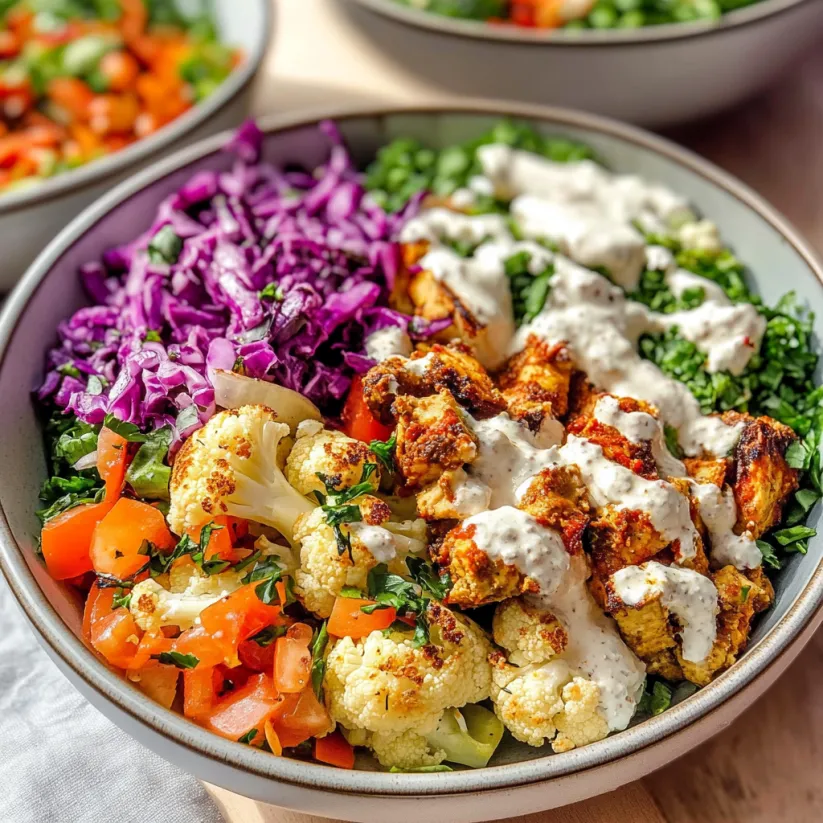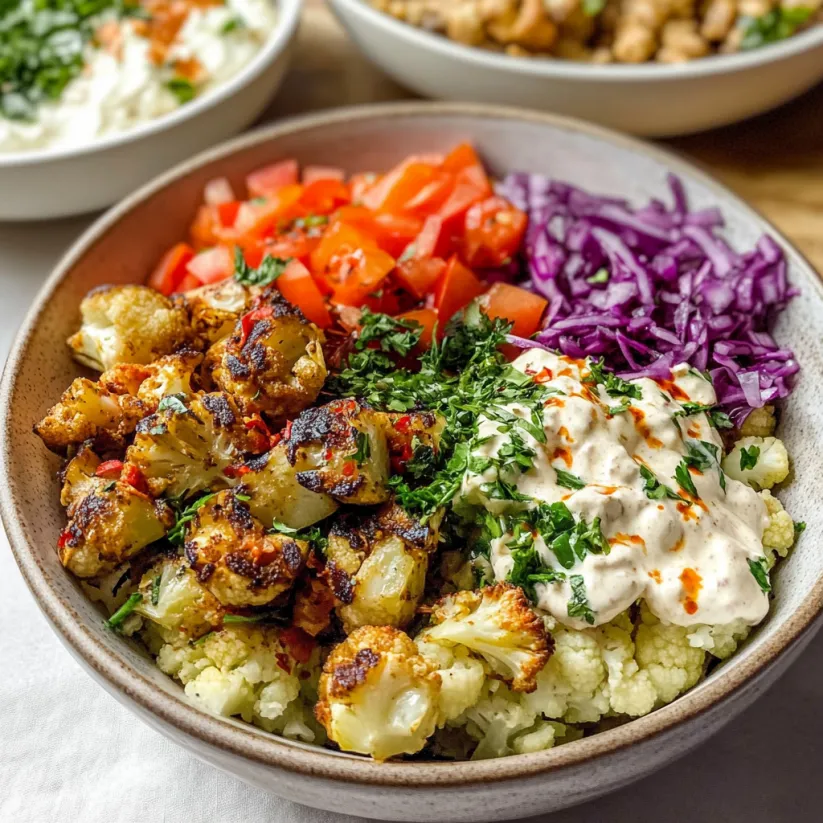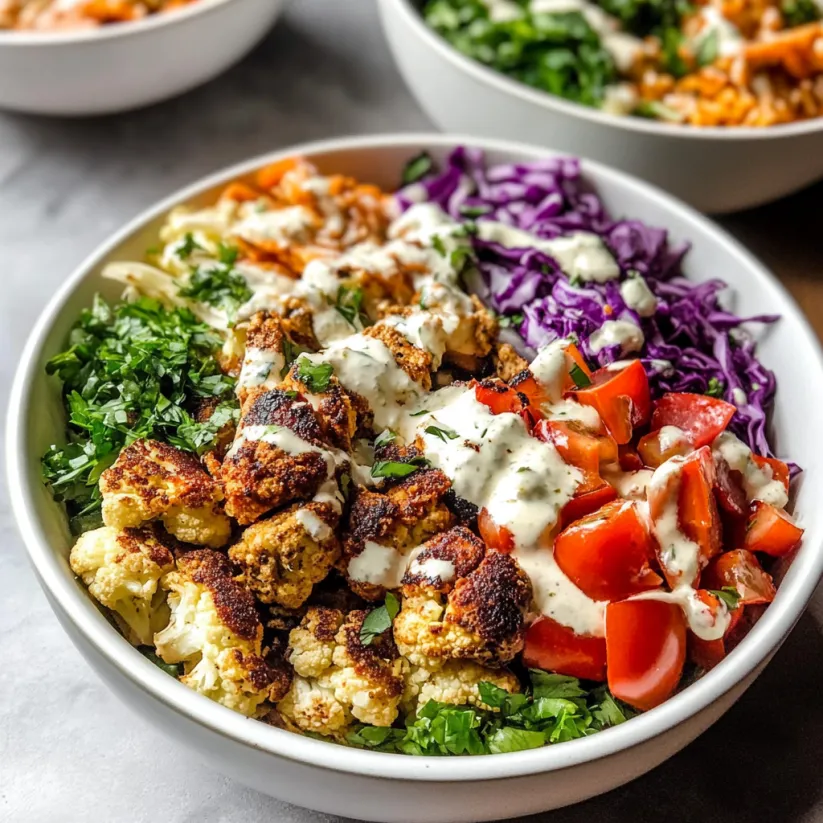 Save Pin
Save Pin
This hearty plant-based Cauliflower Shawarma Bowl transforms humble vegetables into a vibrant, Mediterranean-inspired feast. The combination of warm spiced cauliflower, tangy pickled cabbage, fresh tabbouleh, and creamy tahini sauce creates a perfect balance of flavors and textures that will satisfy even the most dedicated meat-lovers.
I first created this recipe when trying to replicate my favorite restaurant shawarma flavors at home without meat. My skeptical partner who typically reaches for chicken dishes now requests this cauliflower version regularly especially after busy workdays.
Ingredients
- Cauliflower florets: Provides the hearty base, choose a firm head with tight florets and no brown spots
- Curry powder and warming spices: Create authentic shawarma flavor, use fresh spices for best results
- Red cabbage: Adds vibrant color and crunch, look for a dense heavy head with rich purple color
- Bulgur wheat: Traditional in tabbouleh but quinoa and couscous work well for gluten free options
- Fresh herbs: Particularly parsley and mint, bright fresh bunches with no wilting provide essential flavor
- Tahini: High quality brands without separation offer the smoothest, creamiest sauce
- Lemon juice: Fresh squeezed makes all the difference in both the tabbouleh and tahini sauce
Step-by-Step Instructions
- Prepare the Cauliflower:
- Toss cauliflower florets thoroughly with spices ensuring every piece gets coated with the aromatic mixture. The olive oil helps the spices adhere and promotes beautiful golden caramelization. Spread florets in a single layer with space between pieces to encourage roasting rather than steaming.
- Quick Pickle the Cabbage:
- Heat the pickling liquid just enough to dissolve the sweetener and salt without bringing to a full boil. Pour immediately over shredded cabbage while still hot to slightly soften the cabbage while maintaining crunch. Stir occasionally during preparation of other components to ensure even pickling.
- Cook the Grains:
- Follow package directions precisely for perfectly cooked grains. Bulgur typically requires a 1:2 ratio of grain to water simmered until tender about 15 minutes. Allow to cool slightly before mixing with other tabbouleh ingredients to prevent wilting the herbs.
- Assemble the Tabbouleh:
- First create a bright acidic dressing base before adding any solid ingredients. This ensures even distribution of flavors. Add herbs last after grains have cooled to preserve their vibrant color and texture. The tabbouleh should taste quite lemony and herbaceous to balance the rich cauliflower.
- Create Tahini Sauce:
- Begin with a thick paste of tahini, lemon juice, and spices then gradually thin with water until it reaches a pourable consistency. The mixture will initially seize and thicken before smoothing out with additional liquid. Season generously as the sauce will mellow when added to other components.
- Build Your Bowls:
- Start with a base of tabbouleh then arrange cauliflower and pickled cabbage in separate sections for visual appeal and to maintain distinct flavors. Drizzle tahini sauce generously over cauliflower and add a generous dollop of hummus in the center as an anchor point.
 Save Pin
Save Pin
The pickled cabbage is my secret favorite element in this dish. The first time I made it my kitchen filled with that distinctive vinegar aroma that transported me back to my grandmother's table where pickled vegetables appeared at every family gathering. Now whenever I make these bowls that same nostalgic scent fills my home.
Storage and Meal Prep
The beauty of this recipe lies in its make-ahead potential. The tabbouleh actually improves after resting for a day as flavors meld together. Store components separately in airtight containers in the refrigerator for up to four days. The cauliflower will soften slightly but can be revived with a quick reheat in a hot oven for 5 minutes. The tahini sauce might thicken in the refrigerator simply whisk in a teaspoon of warm water before serving.
Creative Variations
This versatile bowl welcomes adaptations based on what you have available. Roasted sweet potatoes make an excellent addition or alternative to cauliflower. For protein enthusiasts, add crispy chickpeas roasted with the same spice blend or falafel for traditional Middle Eastern flair. In summer, replace some parsley with fresh dill and add sliced radishes for extra crunch. The foundation remains the same combining something warm, something pickled, something fresh and something creamy.
 Save Pin
Save Pin
Serving Suggestions
Serve these bowls family style by arranging all components in separate dishes on the table allowing everyone to build their perfect combination. Warm pita bread is essential for scooping up every last bit particularly when toasted and brushed with olive oil and za'atar. For entertaining, consider a shawarma bowl bar with additional toppings like toasted pine nuts, pomegranate seeds, crumbled feta, and various hot sauces for guests to customize their experience.
Commonly Asked Questions
- → Can I substitute the cauliflower with another vegetable?
Yes! While cauliflower works beautifully with the shawarma spices, you can substitute with chickpeas, sweet potatoes, or eggplant. Adjust roasting times accordingly - chickpeas need about 20 minutes, sweet potatoes 25-30 minutes, and eggplant 15-20 minutes.
- → What can I use instead of bulgur for the tabbouleh?
Quinoa makes an excellent gluten-free substitute for bulgur in the tabbouleh. Couscous works well for a quicker cooking option, while finely chopped cauliflower rice creates a grain-free alternative that maintains the authentic texture.
- → How long does the pickled cabbage need to sit?
The cabbage will develop flavor after just 15-20 minutes of pickling, but for best results, let it sit for at least 30 minutes. It continues to improve over time and can be prepared up to 3 days in advance for enhanced flavor and convenience.
- → Why is my tahini sauce bitter or too thick?
Tahini naturally varies in bitterness between brands. If your sauce tastes bitter, add more lemon juice and a touch of maple syrup or honey. For thickness issues, gradually whisk in cold water until you reach your desired consistency. The sauce will thicken as it sits.
- → Can I make these bowls ahead of time?
Yes! The tabbouleh, pickled cabbage, and tahini sauce can all be prepared up to 3 days ahead and stored separately in airtight containers. The roasted cauliflower is best fresh, but complete bowls will keep well assembled in the refrigerator for up to 3 days.
- → What are some good additions to these bowls?
These versatile bowls can be customized with crispy chickpeas, sliced avocado, crumbled feta cheese (if not vegan), olives, roasted red peppers, or a sprinkle of za'atar seasoning. For added protein, consider adding falafel, grilled tofu, or a soft-boiled egg.
